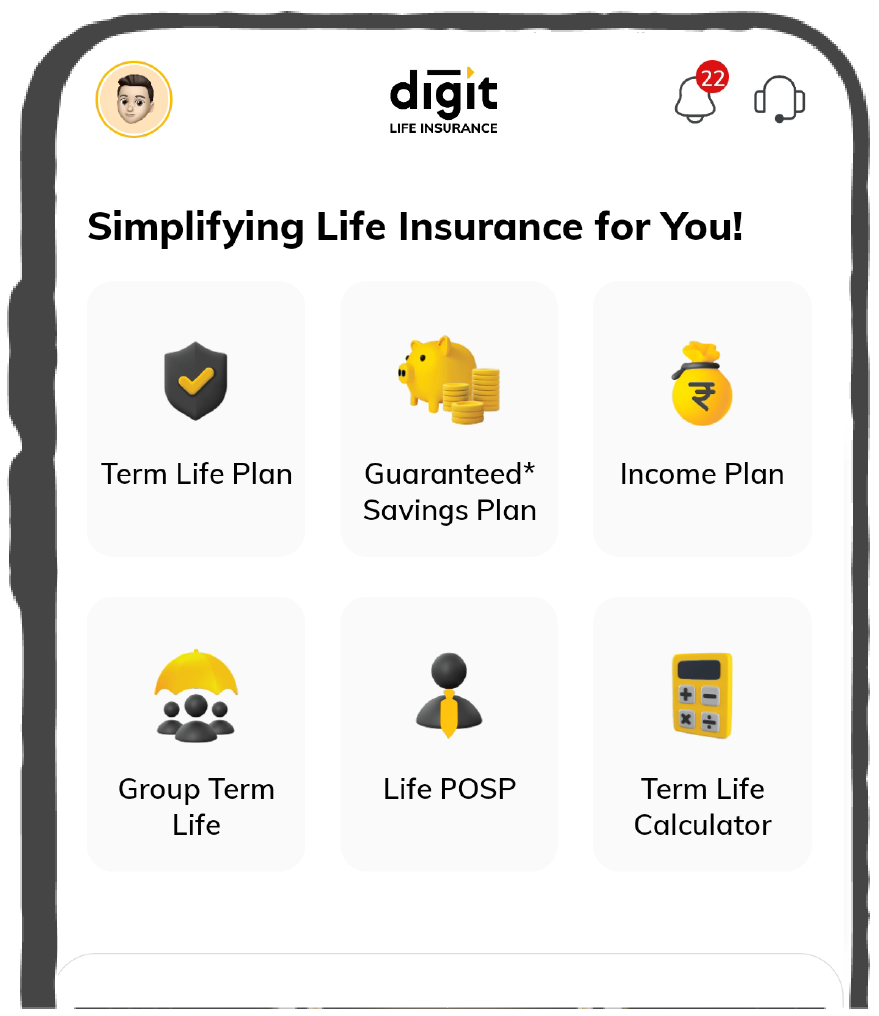Accessibility Options
Life

Life Products
Digit Life is here! To help you save & secure your loved ones' future in the most simplified way.


37K+ Reviews
7K+ Reviews
Scan to download

General

General Products
Simple & Transparent! Policies that match all your insurance needs.


37K+ Reviews
7K+ Reviews
Scan to download

Support
Claims
We'll be there! Whenever and however you'll need us.


37K+ Reviews
7K+ Reviews
Scan to download

Resources
Resources
All the more reasons to feel the Digit simplicity in your life!
 Tools & Calculators
Tools & Calculators


37K+ Reviews
7K+ Reviews
Scan to download

37K+ Reviews
7K+ Reviews
Select Preferred Language
Enter your Mobile Number to get Download Link on WhatsApp.
You can also Scan this QR Code and Download the App.


Simplifying Life Insurance in India
Simplifying Life Insurance in India
Hi There, We are working on our product and launching this soon.
Hi There, We are working on our product and launching this soon.
Submit your details and we will notify you once we launch our Product.
Submit your details and we will notify you once we launch our Product.


Thanks for sharing your details.
We'll reach out to you soon.
What Is Early Retirement & How to Plan for It?

source: birchwoodfp
The decision of an individual to retire depends majorly on factors like lifestyle goals, financial capabilities and unfulfilled hobbies. Although the average age to retire in India is around 60, people nowadays are planning for early retirement to meet new opportunities.
Before finding out the best way to retire early, let’s discuss what early retirement is!
What Is an Early Retirement?
Early retirement is when an individual stops working or quits his/her job before the usual statutory retirement age. For example, retirement in someone’s late 40s can be considered early retirement.
Early retirement is usually planned due to someone's incapability to work further or achieve specific goals. For instance, an individual might go for early retirement to pursue his/her passion for cooking and turn this passion into a source of income.
However, in some instances, one might not plan for early retirement, and the individual might need more assets to last longer. Thus, every individual, whether or not they want an early retirement, should plan for it to be financially secure.
What Is Considered the Early Retirement Age?
For private sector employees, the average age range for retirement can be anything between 60 to 65 years. On the other hand, government employees usually retire when they attain 60 years of age.
It can be considered early retirement if anyone plans to retire before this age. Thus, any age below 60 years can be referred to as early retirement age. Nevertheless, it is ideal to assess your financial responsibilities before deciding your preferred retirement age.
How to Plan for Early Retirement?
1. Start Planning Early
The first criterion for early retirement is early planning, mainly from the day you start earning. Unlike others, who plan a regular retirement, you shouldn’t postpone your financial planning even by one year.2. Estimate Your Expenses
You must budget for the daily expenses post-retirement. This early financial planning will help you estimate your expenses and plan your investments accordingly.3. Make the Right Savings and Investment Plan
If you make a perfect savings and investment plan by allotting your funds correctly, you can earn good returns on retirement. However, ensure your current income is sufficient to bear your investments and strive to avoid recurring debt.4. Actively Manage Your Investment Portfolio
To maximise your returns, investing regularly and managing your investments actively is vital. You must understand which investments will suit you based on your retirement fund plans.5. Get Health Insurance
An individual will likely encounter more health problems as they grow older. Hence, it is essential to have health insurance to protect you from critical illnesses and medical emergencies during old age.
If you make these small sacrifices to your lifestyle now, you can enjoy a stress-free life post-retirement. However, it is equally important to enjoy your present life to live a fulfilled retired life. Thus, follow these simple, early retirement planning tips to live the golden years of your life peacefully.
FAQs about Early Retirement
What are the main indications for early retirement?
Some indications to know whether you are ready for early retirement are as follows:
- If you are free from all your debts like loans, mortgages, credit card dues, etc.
- If you have enough funds to support your dependents and their needs.
- If you have saved and invested aggressively in your entire working period and have sufficient liquid funds.
Is early retirement a good idea?
Early retirement is a good idea if you plan it accordingly and use it to pursue creative or personal interests. Additionally, it can benefit people who wish to live a life away from the mundane complexities of work-life.
However, it is essential to remember that early retirement is not suitable for everyone, and you should consider all your needs before making any decision.
What are the cons of retiring early?
What is the difference between term and permanent life insurance for retirement planning?
Important Articles about Early Retirement Plan
Other Important Articles Related to Retirement & Pension Plans
Renew & Download Policy Document, Check Challan, Credit Score, PUC & more
Anytime, Anywhere. Only on Digit App!

Rated App
Rated App
Scan to Download


IRDA Licensed Life Insurance Company in India - IRDAI Reg No. 165






